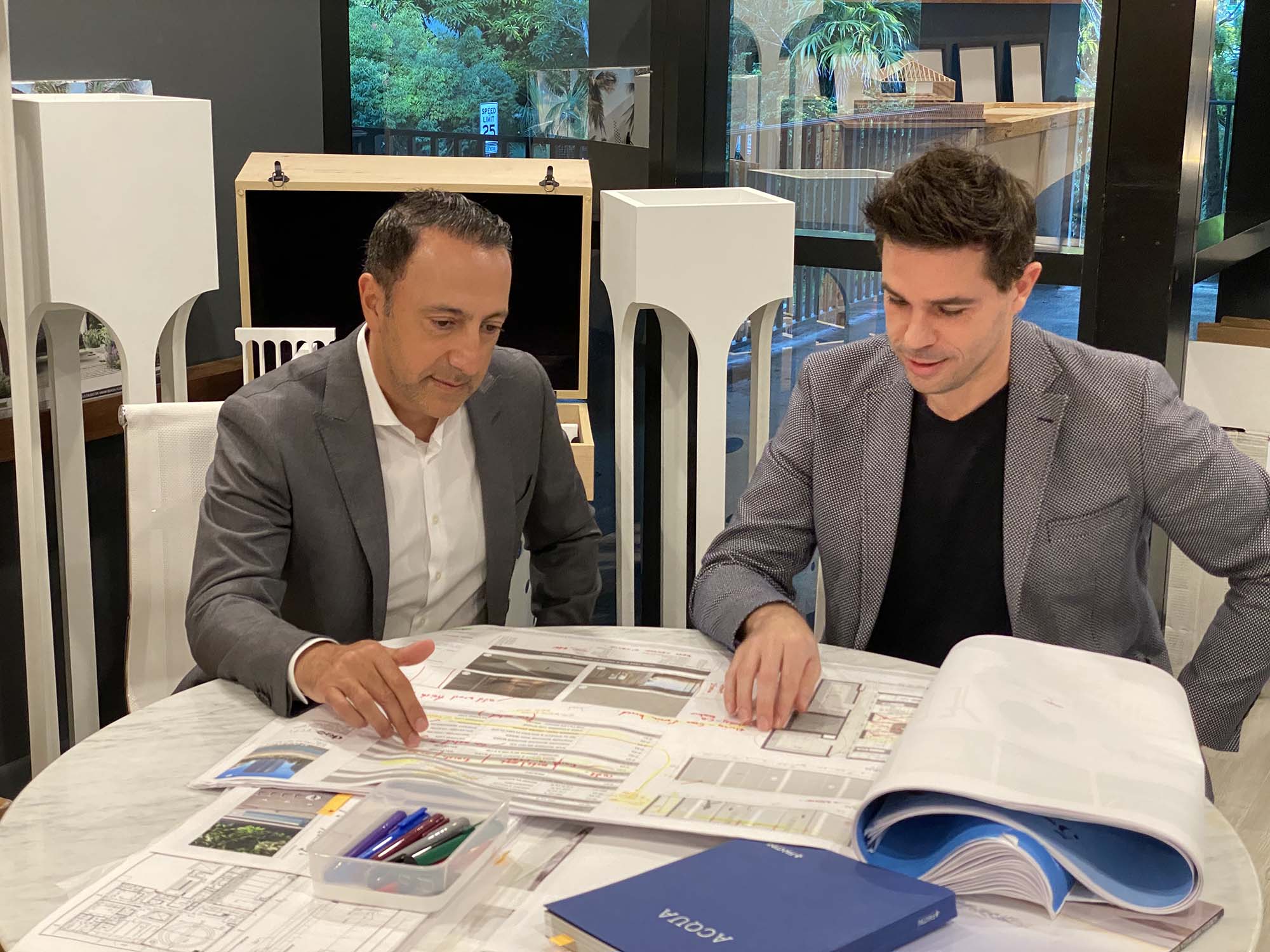

Close


Image courtesy of The Condo Store
Simon S. Mass, CEO of The Condo Store, joined forces with Cogul Lleonart back in 2019 to create a free multi-million dollar Toronto penthouse offering for Raptors NBA Champion, Kawhi Leonard. Although Leonard later signed with the Los Angeles Clippers, the penthouse concept marks one of the most notable collaborations between the two industry titans.
“The truly exciting part is having Doo Architecture and Alexis personally engaged. Having such a global name with an impressive portfolio of really incredible residential work is such a coup for TCS clients,” said Mass. “Just look at some of the projects that Alexis and his firm have undertaken and look at the care and distinctiveness that they bring to all the work they do. Everyone at TCS is so excited.”
Now, Doo Architecture and TCS have collaborated on a bespoke hotel-inspired furniture, décor and home entertainment package that will be available for purchasers at The House of Assembly (HOA) in Toronto’s Junction Triangle. TCS is offering this once in a lifetime investor incentive in October, exclusively to its repeat clientele that invest in HOA.
Mass recently travelled to Miami to meet Cogul Lleonart and the Doo Architecture team to celebrate the commencement of this one-of-a-kind offering.

Image courtesy of The Condo Store
“We are not working as typical brokers and TCS is not a standard real estate company. The value of a tremendously designed fully-decorated unit for a landlord or for a condo owner is very tangible and we are delivering this free to select clients,” said Mass.
“It’s our gift to our clients. At TCS, we always strive to provide our clients with the most impressive value-add incentives and programs so that they can be ahead of the curve and know that they are investing with a firm that cannot be matched by the competition. We are and continue to be a ‘game changer’ when it comes to doing more, every time,” he added.
Livabl caught up with Cogul Lleonart to learn more about his bespoke package with TCS, as well his previous architectural works and insights on current design trends.
Tell us a little about yourself and your career. How did Doo Architecture come to be? How did you get to where you are today?
I was born and raised in Barcelona, Spain. I hold a Masters in Architecture and Urban Planning which I earned in 2005 from the ESARQ Catalunya and in 2007 from Universitat de Barcelona. As a young entrepreneur, I always take the creative approach to the business world, creating a number of start-ups fueled by the philosophy that design enhances the experience of living, working or playing in any space.
I’ve always been driven by the idea of “creating” value, provoking, and making a mark. Not all I do is useful, not all I do is needed, but all I do has a purpose. For me it is vocational, it has always been and the passion for architecture was the driving force to start a creative-driven company ethos, and this is Doo Architecture. There is one main principle at the company — architecture is incitement. If it creates an emotional reaction to people, then it meets its purpose.
Doo Architecture happened as a result of merging this European design culture into the American market and other international locations. Based in Miami and Barcelona, Doo Architecture is a collective of creators in the fields of architecture, urbanism, design, research and branding. Each of us comes with a unique professional experience and an array of diverse projects throughout Europe, Asia Pacific and North and South America. Doo Architecture applies a multi-disciplinary philosophy and an eye for social impact to everything we design and create, whether it’s a home or an office or a retail store, a building, or the interior or exterior landscape.

Image courtesy of The Condo Store
Over the past five years, what brands and major projects have you been involved with? What would be some of your most notable or favorite projects to date?
We worked with developers like Oko Group, CNC development, Multiplan, Lionheart and many others, but we have also worked with known brands such as Christian Dior, LVMH Group, Versace, Ritz Carlton, Aman, One Hotel, Softbank, Goya products, Silverspot Cinema, Bang, Moet Chandon and many more. In regards to projects, I will have to say one of the most significant projects we are working on nowadays is a private residence in Miami in partnership with the most renowned furniture company, Casa B&B Italia. Also, we did create the concept of Café Dior around the world in locations like Miami, Las Vegas and France.
But besides those projects, we also focused on the design of objects and furniture, what we like to call the “small scale.” This is a sister company called Cogul Design Lab, with the intent of rescuing a family brand born in Cuba in the 1940s that was founded by Angel Cogul. In the 1940s, the brand existed as a candy factory, but more than that, Cogul was known for his innovation in the industry and his forward thinking. All the progress and advances were drastically stopped, and the factory went to sleep.
Eighty years later, Alexis Cogul Lleonart, grandson of Angel and the son of Aurelio Cogul, wanted to rescue the same aim and spirit that his family created by re-birthing and re-branding the company to create a design and research lab.
How did Doo Architecture connect with The Condo Store? How did the idea for the Bespoke Hotel Décor Package come together?
Years ago, I had the pleasure of meeting The Condo Store CEO and founder Simon S. Mass at a development and architecture conference. Since that day, we still keep in touch and have collaborated on several projects, including the very interesting project with NBA star Kawhi Leonard if he was to stay, play and live in Toronto.
Simon had asked me to design and help with the penthouse he was offering to Mr. Leonard. All those years and projects lead to a fruitful professional dialogue on how to create value through design and connect the end user to that experience, and this is how the Bespoke Hotel-Inspired Furniture, Decor and Home Entertainment package came up. Since I also consider myself a furniture designer, for many years I worked with the top Italian brands designing furniture pieces and objects. With that experience came the idea of providing this knowledge to the end user, to a buyer.
Mr. Mass is always researching the idea to bring design and value to the user, to the inhabitant and we have always been interested in democratizing bespoke design on a bigger scale without losing the uniqueness of a good idea, and this is precisely what this program is all about.

Image courtesy of The Condo Store
You work with some of the world’s largest and most successful furniture and decor firms. What do you plan to bring to Toronto with your involvement on The Condo Store’s Bespoke Hotel Décor Package at The House of Assembly? Can you tell us a little bit about what the design and decor package will entail?
I think the whole idea is not to provide a package. It is to present a tailored project, a tailored experience. I’m a believer that design creates value, and that value provokes emotion. I do believe this collaboration and this program we came up with together not only adds on to the functionality of the space and how it is being laid out, but also brings the concept of creating uniqueness.
It is not just selecting a few pieces, it is all about how those pieces and the residence layout will interact together and create a synergy. And in that matter, I do believe we can add on to it.
When custom-designing a condo suite that you can’t find in a typical developer-finished unit, what goes into that process? Where do you pull inspiration from and how do you develop the persona of the residence?
I believe the difference between a developer-finished unit and a designed unit is the value of taking care.
We look into the units independently, study every corner, not on how to be efficient or maximize space but in a much different way. We look into every space next to the other, we understand the value of light, the value of layout and we try to recreate the experience of living in that space in order to propose a layout, a package, that can enhance and improve a developed unit but also make it unique. More importantly, to show its potential.
I’m a believer that if we design something and do not create any reaction to it, it just won’t be done. It is like getting dressed — it can be done casually or with intention to be unique. We aim and thrive for uniqueness.
You travel all over the world for meetings, which means you’ve probably spent a lot of time in hotels and short-term lodgings. When traveling, what do you prefer in terms of an AirBnb or hotel stay?
For me it is all about location and the relationship of the city or place that I’m travelling to and the space I’m staying in. I did both, and I had great experiences.
For me the value remains on the memory that this staying created, more than if it was luxurious or affordable, light or dark, small or big, it is all about the experience and for me, design is the same — an experience, not just a look.

Image courtesy of The Condo Store
As an accomplished architect and advisor to many developers, what are your thoughts on master-planned communities where retail, office and residential spaces all come together to form a new style of community living?
I think it is great as long as they are designed within the right scale, proportions and intentions. I think the most difficult thing to create is to develop programs that are adequate for the area and provide synergies that create other uses. We call this placemaking nowadays and it is not easy, but when well done, the results are always surprising and relevant.
I believe, the best developed communities are the ones that are done based on the research and observation of the area prior to development, and not deducting what may be good for that place. I think designing mix-used developments are successful when they approach different uses and habitants but not force their proximity.
Architecture and design is always changing. What trends from this past year stand out to you, and how do you think this will translate to new construction project design?
It is true. Architecture we can say is kind of fashionable and trends differently. I think it has a direct reaction to what is going on in society. For example, for the good or the bad, COVID-19 changed the way we look into the way of living and now we value much more the open space, or what we call being free. So I think this I can see is one of the bigger factors that are changing the way we think of architecture.
Also, something I’m observing more and more every day is to create with flexibility in mind. The constant changing and speed of living is affecting design, and designers are taking on that challenge. I believe we will be seeing furniture pieces that serve several purposes and the ability of spaces to accommodate different programs if needed, based on the needs of a mutating habitant.




